Blog & Latest Updates
Fly Fishing Articles
Insects by Common Name


> > The Madison River
Closeup insects from the Madison River
Male Neoleptophlebia heteronea (Blue Quill) Mayfly Spinner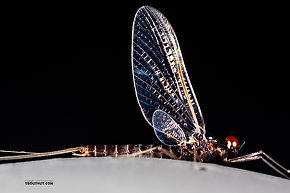 View 12 PicturesI keyed this one out to species on the microscope because it was too small for the genitalia to show the distinguishing characteristics in the images here.
View 12 PicturesI keyed this one out to species on the microscope because it was too small for the genitalia to show the distinguishing characteristics in the images here.
 View 12 PicturesI keyed this one out to species on the microscope because it was too small for the genitalia to show the distinguishing characteristics in the images here.
View 12 PicturesI keyed this one out to species on the microscope because it was too small for the genitalia to show the distinguishing characteristics in the images here.Collected July 1, 2019 from the Madison River in Montana
Added to Troutnut.com by Troutnut on July 18, 2019
Added to Troutnut.com by Troutnut on July 18, 2019
Male Ephemerella dorothea infrequens (Pale Morning Dun) Mayfly Spinner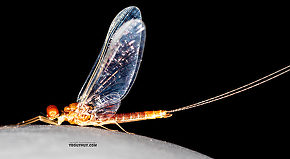 View 6 PicturesThis spinner was collected in proximity to this dun and this other dun, so one of them is likely the same species. Note for ID purposes that this one is missing one of its cerci (Cercus: The left and right "tails" of an insect are known as the cerci or caudal cerci. The middle tail of a three-tailed insect is not.).
View 6 PicturesThis spinner was collected in proximity to this dun and this other dun, so one of them is likely the same species. Note for ID purposes that this one is missing one of its cerci (Cercus: The left and right "tails" of an insect are known as the cerci or caudal cerci. The middle tail of a three-tailed insect is not.).
 View 6 PicturesThis spinner was collected in proximity to this dun and this other dun, so one of them is likely the same species. Note for ID purposes that this one is missing one of its cerci (Cercus: The left and right "tails" of an insect are known as the cerci or caudal cerci. The middle tail of a three-tailed insect is not.).
View 6 PicturesThis spinner was collected in proximity to this dun and this other dun, so one of them is likely the same species. Note for ID purposes that this one is missing one of its cerci (Cercus: The left and right "tails" of an insect are known as the cerci or caudal cerci. The middle tail of a three-tailed insect is not.).Collected July 1, 2019 from the Madison River in Montana
Added to Troutnut.com by Troutnut on July 18, 2019
Added to Troutnut.com by Troutnut on July 18, 2019
Male Malenka tina (Tiny Winter Black) Stonefly Adult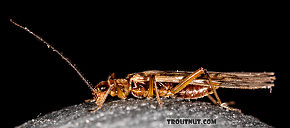 View 7 PicturesThis is the smallest stonefly I've ever collected, with a body only 5.5 mm long.
View 7 PicturesThis is the smallest stonefly I've ever collected, with a body only 5.5 mm long.
Although not in-focus in my pictures, its first tarsal segment is similar in length to the third, while the second is much shorter. This helps with family-level identification.
Examining this specimen under a microscope shows a membranous lobe on the dorsal (Dorsal: Top.) base of the cerci (Cercus: The left and right "tails" of an insect are known as the cerci or caudal cerci. The middle tail of a three-tailed insect is not.), which is the key characteristic in Merritt & Cummins (4th ed.) to place the genus definitively as Malenka.
Following the species key in Jewett Jr's Stoneflies of the Pacific Northwest, the species appears to be Malenka tina. My dissecting microscope seems to show sternite (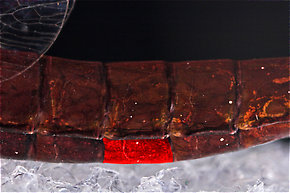 Sternite: The bottom (ventral) part of a single segment on an insect's abdomen.) 9 ending in a rounded knob, which distinguishes it from Malenka bifurcata, but the detail is hard to work out.
Sternite: The bottom (ventral) part of a single segment on an insect's abdomen.) 9 ending in a rounded knob, which distinguishes it from Malenka bifurcata, but the detail is hard to work out.
Also worth noting is that Montana appears to have this species, whereas birfucata is not know there: http://fieldguide.mt.gov/displaySpecies.aspx?family=Nemouridae
 View 7 PicturesThis is the smallest stonefly I've ever collected, with a body only 5.5 mm long.
View 7 PicturesThis is the smallest stonefly I've ever collected, with a body only 5.5 mm long.Although not in-focus in my pictures, its first tarsal segment is similar in length to the third, while the second is much shorter. This helps with family-level identification.
Examining this specimen under a microscope shows a membranous lobe on the dorsal (Dorsal: Top.) base of the cerci (Cercus: The left and right "tails" of an insect are known as the cerci or caudal cerci. The middle tail of a three-tailed insect is not.), which is the key characteristic in Merritt & Cummins (4th ed.) to place the genus definitively as Malenka.
Following the species key in Jewett Jr's Stoneflies of the Pacific Northwest, the species appears to be Malenka tina. My dissecting microscope seems to show sternite (

One sternite of this Isonychia bicolor mayfly spinner is highlighted in red.
Also worth noting is that Montana appears to have this species, whereas birfucata is not know there: http://fieldguide.mt.gov/displaySpecies.aspx?family=Nemouridae
Collected July 1, 2019 from the Madison River in Montana
Added to Troutnut.com by Troutnut on July 18, 2019
Added to Troutnut.com by Troutnut on July 18, 2019
Male Ephemerella dorothea infrequens (Pale Morning Dun) Mayfly Spinner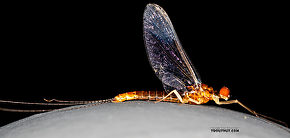 View 10 Pictures
View 10 Pictures
 View 10 Pictures
View 10 PicturesCollected July 1, 2019 from the Madison River in Montana
Added to Troutnut.com by Troutnut on July 18, 2019
Added to Troutnut.com by Troutnut on July 18, 2019
Hydropsyche (Spotted Sedges) Caddisfly Adult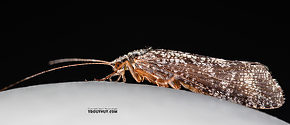 View 11 PicturesI haven't keyed this specimen out, but I am instead placing it in Hydropsyche based on the striking visual similarity to this one, which I did key out.
View 11 PicturesI haven't keyed this specimen out, but I am instead placing it in Hydropsyche based on the striking visual similarity to this one, which I did key out.
 View 11 PicturesI haven't keyed this specimen out, but I am instead placing it in Hydropsyche based on the striking visual similarity to this one, which I did key out.
View 11 PicturesI haven't keyed this specimen out, but I am instead placing it in Hydropsyche based on the striking visual similarity to this one, which I did key out.Collected June 30, 2019 from the Madison River in Montana
Added to Troutnut.com by Troutnut on July 17, 2019
Added to Troutnut.com by Troutnut on July 17, 2019
Male Cheumatopsyche (Little Sister Sedges) Caddisfly Adult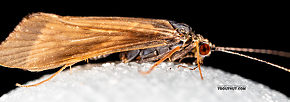 View 12 PicturesI didn't identify this one directly, but I eventually identified one of several I collected from the same swarms that appeared to be of the same species. (I lost track of which specimen was which in storage.) The microscope pictures come from one of these specimen, not necessarily the same specimen as the DSLR pictures. They key to Cheumatopsyche, and the hind wing venation (Venation: The pattern in which the veins on the wings of an insect are arranged. It is usually one of the most useful identifying characteristics.) that separates them from Hydropsyche is pretty clear in the attached picture as well as another specimen I checked under the scope.
View 12 PicturesI didn't identify this one directly, but I eventually identified one of several I collected from the same swarms that appeared to be of the same species. (I lost track of which specimen was which in storage.) The microscope pictures come from one of these specimen, not necessarily the same specimen as the DSLR pictures. They key to Cheumatopsyche, and the hind wing venation (Venation: The pattern in which the veins on the wings of an insect are arranged. It is usually one of the most useful identifying characteristics.) that separates them from Hydropsyche is pretty clear in the attached picture as well as another specimen I checked under the scope.
This specimen was one of tens of thousands we saw on a July 1st evening on the Madison, beginning with big swarms around every vehicle and tree at the Eight Mile Ford access point and continuing all up and down the river bank. We somehow didn't catch any trout, perhaps because they were stuffed with pupae from when these things emerged. Or maybe we just weren't fishing well. Either way, this one represents a major hatch there.
I somehow forgot to photograph this important specimen against the hooks size chart, but fortunately I preserved a few. The body length is about 6 mm, and total length from head to wingtip is 9 mm.
 View 12 PicturesI didn't identify this one directly, but I eventually identified one of several I collected from the same swarms that appeared to be of the same species. (I lost track of which specimen was which in storage.) The microscope pictures come from one of these specimen, not necessarily the same specimen as the DSLR pictures. They key to Cheumatopsyche, and the hind wing venation (Venation: The pattern in which the veins on the wings of an insect are arranged. It is usually one of the most useful identifying characteristics.) that separates them from Hydropsyche is pretty clear in the attached picture as well as another specimen I checked under the scope.
View 12 PicturesI didn't identify this one directly, but I eventually identified one of several I collected from the same swarms that appeared to be of the same species. (I lost track of which specimen was which in storage.) The microscope pictures come from one of these specimen, not necessarily the same specimen as the DSLR pictures. They key to Cheumatopsyche, and the hind wing venation (Venation: The pattern in which the veins on the wings of an insect are arranged. It is usually one of the most useful identifying characteristics.) that separates them from Hydropsyche is pretty clear in the attached picture as well as another specimen I checked under the scope. This specimen was one of tens of thousands we saw on a July 1st evening on the Madison, beginning with big swarms around every vehicle and tree at the Eight Mile Ford access point and continuing all up and down the river bank. We somehow didn't catch any trout, perhaps because they were stuffed with pupae from when these things emerged. Or maybe we just weren't fishing well. Either way, this one represents a major hatch there.
I somehow forgot to photograph this important specimen against the hooks size chart, but fortunately I preserved a few. The body length is about 6 mm, and total length from head to wingtip is 9 mm.
Collected July 1, 2019 from the Madison River in Montana
Added to Troutnut.com by Troutnut on July 18, 2019
Added to Troutnut.com by Troutnut on July 18, 2019
Male Leptoceridae Caddisfly Adult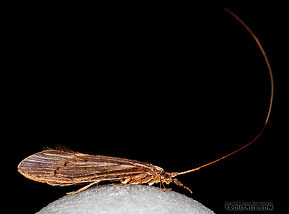 View 12 Pictures
View 12 Pictures
 View 12 Pictures
View 12 PicturesCollected June 29, 2019 from the Madison River in Montana
Added to Troutnut.com by Troutnut on July 17, 2019
Added to Troutnut.com by Troutnut on July 17, 2019
Odonata-Zygoptera (Damselflies) Damselfly Adult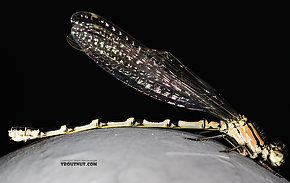 View 8 Pictures
View 8 Pictures
 View 8 Pictures
View 8 PicturesCollected June 30, 2019 from the Madison River in Montana
Added to Troutnut.com by Troutnut on July 17, 2019
Added to Troutnut.com by Troutnut on July 17, 2019
Male Lepidostoma (Little Brown Sedges) Little Brown Sedge Adult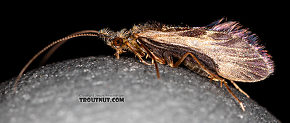 View 7 PicturesOn an evening filled with millions of caddisflies, this one stood out as the only one of its kind that found its way into my net. Dave Ruiter identified it from the photos as a Lepidostoma specimen in the pluviale species group.
View 7 PicturesOn an evening filled with millions of caddisflies, this one stood out as the only one of its kind that found its way into my net. Dave Ruiter identified it from the photos as a Lepidostoma specimen in the pluviale species group.
 View 7 PicturesOn an evening filled with millions of caddisflies, this one stood out as the only one of its kind that found its way into my net. Dave Ruiter identified it from the photos as a Lepidostoma specimen in the pluviale species group.
View 7 PicturesOn an evening filled with millions of caddisflies, this one stood out as the only one of its kind that found its way into my net. Dave Ruiter identified it from the photos as a Lepidostoma specimen in the pluviale species group.Collected July 1, 2019 from the Madison River in Montana
Added to Troutnut.com by Troutnut on July 18, 2019
Added to Troutnut.com by Troutnut on July 18, 2019
Male Ephemerella dorothea infrequens (Pale Morning Dun) Mayfly Dun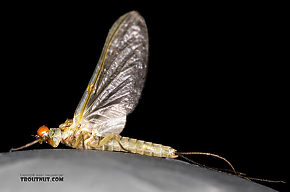 View 7 PicturesThis dun was collected in proximity to this spinner.
View 7 PicturesThis dun was collected in proximity to this spinner.
 View 7 PicturesThis dun was collected in proximity to this spinner.
View 7 PicturesThis dun was collected in proximity to this spinner.Collected July 1, 2019 from the Madison River in Montana
Added to Troutnut.com by Troutnut on July 18, 2019
Added to Troutnut.com by Troutnut on July 18, 2019
Start a Discussion of the Madison River:
Top 10 Fly Hatches
Top Gift Shop Designs
Eat mayflies.
Top Insect Specimens
Miscellaneous Sites
Troutnut.com is copyright © 2004-2024 Jason
Neuswanger (email Jason). See my FAQ for information about use of my images.
 privacy policy
privacy policy
